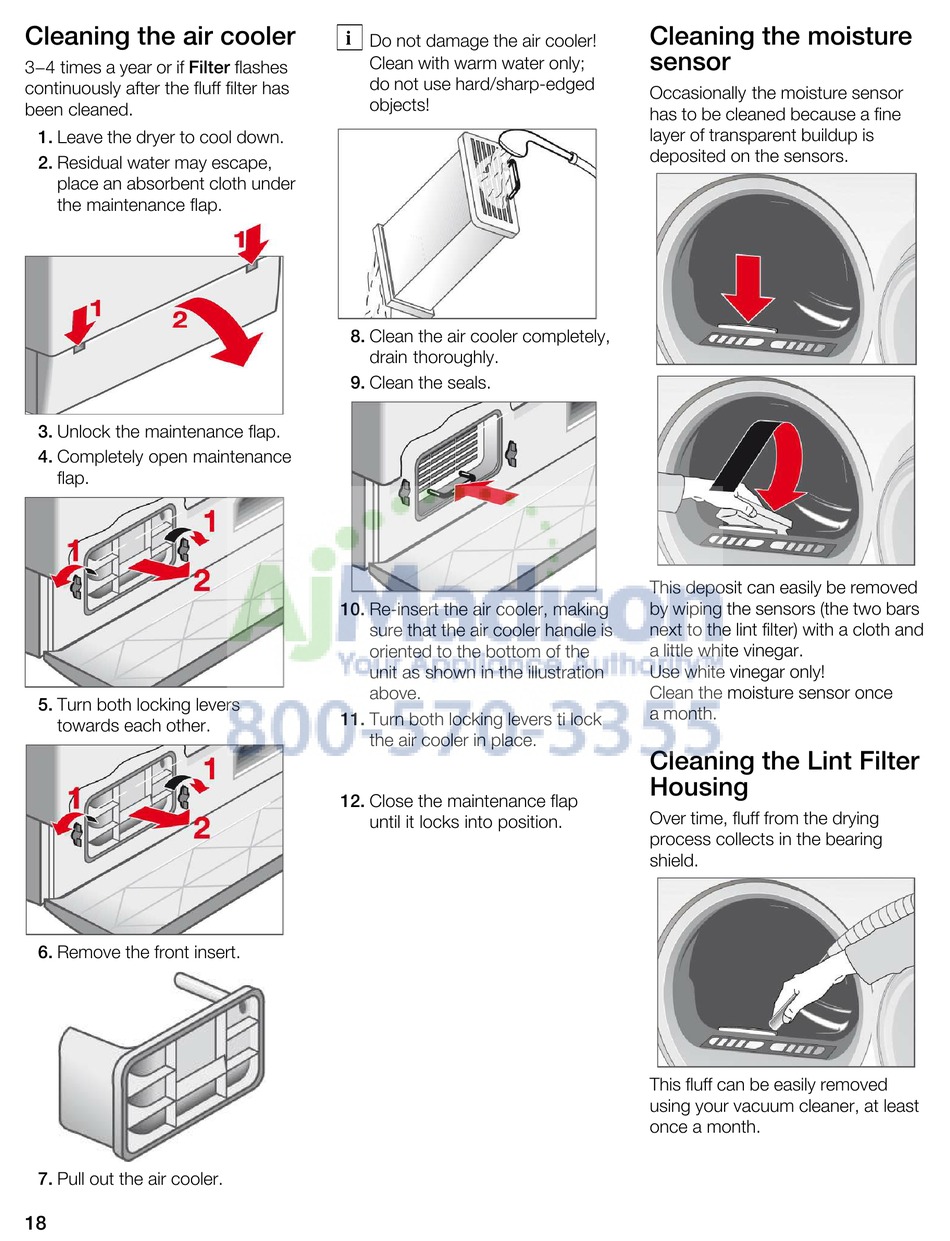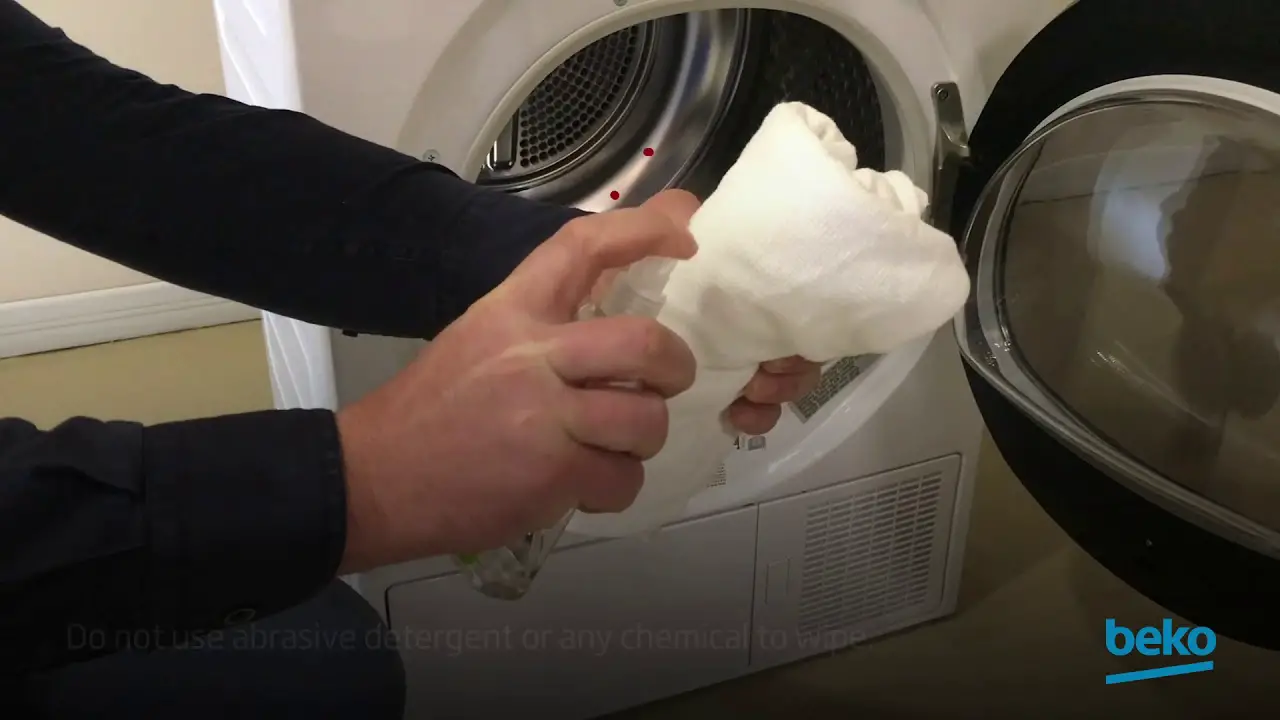To clean the Bosch dryer moisture sensor, gently wipe it with a soft cloth and mild detergent. Avoid using abrasive materials.
Is your Bosch dryer not drying properly and in need of maintenance? One common culprit is a dirty moisture sensor. Regular cleaning of the moisture sensor is essential to ensure optimal dryer performance. By following a few simple steps, you can effectively clean the Bosch dryer moisture sensor and keep your appliance running efficiently.
In this guide, we will walk you through the process of cleaning the moisture sensor in your Bosch dryer to help you maintain its functionality and extend its lifespan. Let’s dive in and learn how to properly clean your Bosch dryer moisture sensor.
Contents
- Introduction To Bosch Dryer Maintenance
- Identifying The Moisture Sensor Location
- Preparing The Dryer For Cleaning
- Step-by-step Cleaning Process
- Troubleshooting Common Sensor Issues
- Reassembling The Dryer Post-cleaning
- Preventive Measures To Keep The Sensor Clean
- Conclusion: Maximizing Dryer Efficiency
- Frequently Asked Questions
- Conclusion
Introduction To Bosch Dryer Maintenance
Maintaining your Bosch dryer is essential to ensure its optimal performance and longevity. Regular maintenance, including cleaning the moisture sensor, is crucial to prevent issues and keep your dryer running efficiently. In this article, we will delve into the importance of regular cleaning and the role of the moisture sensor in Bosch dryer maintenance.
Importance Of Regular Cleaning
Regular cleaning of your Bosch dryer is imperative to prevent lint buildup and maintain its effectiveness. When lint accumulates, it can obstruct airflow, leading to longer drying times and potential overheating. Additionally, clean dryers are more energy-efficient, helping you save on utility costs.
Role Of The Moisture Sensor
The moisture sensor in your Bosch dryer plays a pivotal role in ensuring clothes are dried thoroughly while conserving energy. This sensor detects the moisture level in the laundry and adjusts the drying time accordingly, promoting efficient and precise drying. Regular cleaning of the moisture sensor is crucial to maintain its accuracy and prevent malfunctions.

Credit: greenlivingideas.com
Identifying The Moisture Sensor Location
To clean the Bosch dryer moisture sensor, first, locate its position within the drum. Typically, it is found near the lint screen. Gently wipe the sensor with a clean cloth to remove any lint or debris, ensuring accurate moisture detection for efficient drying cycles.
Identifying the Moisture Sensor Location: When it comes to efficiently drying clothes in your Bosch dryer, the moisture sensor plays a crucial role. Over time, it can become dirty and affect the accuracy of the sensor, leading to longer drying times and higher energy bills. Therefore, it’s important to keep the sensor clean. Before you start cleaning, you need to identify the moisture sensor’s location in your specific Bosch dryer model. Let’s take a closer look at how to do this. Model-Specific Sensor Placement: Bosch dryers have different sensor placements depending on the model. Here are some common locations:
- On the back wall of the drum
- Behind the lint filter
- At the front of the dryer’s drum
- Inside the dryer’s door
To find out the exact location of the moisture sensor in your Bosch dryer model, refer to your dryer’s user manual. It will provide you with the necessary information and help you locate the sensor with ease. Tools Needed for Cleaning: Once you’ve located the moisture sensor, you’ll need the following tools to clean it:
| Bristled brush or a microfiber cloth | Warm, soapy water |
|---|---|
| A vacuum cleaner with a hose attachment | Isopropyl alcohol (optional) |
Make sure to unplug the dryer from the power source before you start cleaning. In conclusion, identifying the moisture sensor location is the first step in cleaning your Bosch dryer’s moisture sensor. Once you’ve located the sensor, you’ll need some simple tools to clean it. Keep in mind that keeping the moisture sensor clean is essential for the efficient operation of your dryer.
Preparing The Dryer For Cleaning
To clean the Bosch dryer moisture sensor effectively, start by unplugging the appliance. Remove the lint filter and vacuum any debris for optimal sensor performance. Wipe the sensor with a cloth dampened with water and a mild detergent to ensure accurate moisture detection.
Safety First: Unplugging The Dryer
Before beginning any cleaning procedures, ensure the dryer is unplugged to avoid any electrical accidents.
Accessing The Sensor
Locate the moisture sensor typically found inside the dryer drum area. Carefully remove any obstructions to access the sensor.
Step-by-step Cleaning Process
When it comes to maintaining the efficiency of your Bosch dryer, cleaning the moisture sensor is a crucial step. The moisture sensor helps the dryer to detect the dampness of the clothes, ensuring they are dried thoroughly. Regular cleaning is necessary to keep the sensor working effectively. Here’s a simple step-by-step guide to cleaning the Bosch dryer moisture sensor, ensuring optimal performance and longevity.
Removing Lint And Debris
Start by unplugging the dryer to ensure safety. Locate the moisture sensor, usually found near the lint filter. Using a soft bristle brush or a vacuum cleaner with a nozzle attachment, carefully remove any visible lint and debris from the sensor and its surrounding area. Take care not to damage the sensor during this process.
Choosing The Right Cleaning Agents
When it comes to cleaning the Bosch dryer moisture sensor, it’s important to use the right cleaning agents. Opt for a mild detergent or soap and water solution to gently clean the sensor. Avoid using harsh chemicals or abrasive materials, as these can cause damage to the sensor and affect its performance.
Troubleshooting Common Sensor Issues
To effectively clean the Bosch dryer moisture sensor, gently wipe it with a soft cloth and mild detergent. Ensure the sensor is free from debris for optimal performance and accurate drying cycles. Regular maintenance helps troubleshoot common sensor issues and improves dryer efficiency.
Sensor Not Detecting Moisture Accurately
If your Bosch dryer’s moisture sensor is not accurately detecting the level of moisture in your laundry, there are a few troubleshooting steps you can take before seeking professional help. First, check the sensor for any visible debris or buildup that may be interfering with its function. Use a soft cloth or brush to gently clean the sensor, taking care not to damage any delicate components. Next, verify that the sensor is properly positioned within the drum of the dryer. If it has become dislodged or shifted, it may not be able to detect the moisture levels in the laundry accurately. If these steps do not resolve the issue, it may be necessary to recalibrate the moisture sensor. Refer to the manufacturer’s instructions for your specific Bosch dryer model to learn how to perform this recalibration process.
When To Seek Professional Help
If you have attempted the above troubleshooting steps and your Bosch dryer’s moisture sensor continues to malfunction, it may be time to seek professional assistance. Contact a certified Bosch technician to diagnose and repair any underlying issues with the moisture sensor. Attempting to disassemble or repair the sensor without the proper expertise may result in further damage to your appliance. By addressing sensor issues promptly, you can ensure that your Bosch dryer continues to operate efficiently, providing you with consistently dry laundry without the need for manual adjustments.

Credit: www.manualslib.com
Reassembling The Dryer Post-cleaning
After cleaning the Bosch dryer moisture sensor, carefully reassemble the dryer components. Ensure all parts are securely put back together for optimal sensor functionality. Double-check connections and test the dryer to confirm proper reassembly.
Ensuring Sensor Alignment
Check that the moisture sensor is properly aligned before using the dryer.
Safety Checks Before Use
Before operating the dryer, conduct safety checks to ensure everything is in order.
Preventive Measures To Keep The Sensor Clean
To keep your Bosch dryer’s moisture sensor clean, wipe it regularly with a soft cloth. Avoid using harsh chemicals to maintain its accuracy and efficiency in detecting moisture levels. Regular cleaning ensures optimal performance and prolongs the sensor’s lifespan.
When it comes to keeping your Bosch dryer running efficiently, regular maintenance is key. One important component to keep clean is the moisture sensor. If the sensor is dirty or covered in residue, it can affect the accuracy of the dryer’s automatic cycle, resulting in longer drying times or even damage to your clothes. Here are some preventive measures you can take to keep the sensor clean and ensure your dryer works properly.
Regular Maintenance Tips
Regularly cleaning the dryer’s lint filter is an important step in preventing lint buildup on the moisture sensor. However, it’s also important to clean the sensor itself on a regular basis. To do this, simply wipe the sensor with a clean, dry cloth after each use. Be sure to avoid using any chemicals or water, as this can damage the sensor and affect its performance.
Best Practices For Dryer Use
In addition to regular cleaning, there are some best practices you can follow to prevent moisture sensor buildup. First, avoid overloading your dryer, as this can cause clothes to bunch up and prevent proper air circulation. Second, try to avoid using dryer sheets, as they can leave a residue on the sensor. Finally, make sure your clothes are completely dry before removing them from the dryer, as damp clothes can leave moisture behind on the sensor. By following these preventive measures, you can keep your Bosch dryer’s moisture sensor clean and functioning properly, ensuring your clothes are dried efficiently and effectively.

Credit: www.familyhandyman.com
Conclusion: Maximizing Dryer Efficiency
Proper maintenance of your Bosch dryer’s moisture sensor is crucial for ensuring optimal performance and energy efficiency. By understanding the benefits of a clean moisture sensor and knowing when to schedule the next cleaning, you can keep your dryer operating at its best, saving time and energy.
Benefits Of A Clean Moisture Sensor
A clean moisture sensor enables the dryer to accurately gauge the level of moisture in the clothes, leading to more precise drying cycles. This not only helps in preventing over-drying but also ensures that the clothes are dried thoroughly, reducing the need for additional drying cycles.
Furthermore, a clean sensor promotes energy efficiency, as the dryer operates more efficiently when it doesn’t have to run unnecessary or prolonged cycles due to inaccurate moisture readings.
When To Schedule Next Cleaning
It’s recommended to clean the moisture sensor every six months or more frequently if you notice longer drying times or damp clothes after a drying cycle. Regularly checking and cleaning the sensor can help prevent performance issues and maintain the efficiency of your Bosch dryer.
Frequently Asked Questions
How To Clean Dryer Moisture Sensor?
Clean the dryer moisture sensor by wiping it with a soft cloth and rubbing it with alcohol. Ensure it’s dry before use.
How Do I Clean The Condenser On My Bosch Tumble Dryer?
To clean the condenser on your Bosch tumble dryer, remove the condenser unit and rinse it under running water. Use a soft brush to remove any lint or debris. Make sure it’s completely dry before reinserting it into the dryer.
Regular cleaning helps maintain optimal dryer performance.
Why Does My Bosch Dryer Keep Stopping After A Few Minutes?
The Bosch dryer might be stopping due to a clogged lint filter, a faulty thermostat, or an overheating issue. Check the lint filter and clean it if necessary. Also, make sure the dryer is not overloaded and has enough ventilation.
If the problem persists, contact a professional technician for further assistance.
Why Does My Bosch Dryer Stop Drying?
Your Bosch dryer may stop drying due to clogged vents, a faulty heating element, or a malfunctioning thermostat. Regular maintenance can help prevent these issues.
Conclusion
Maintaining your Bosch dryer’s moisture sensor is key to efficient performance. Regular cleaning ensures accurate drying cycles. Follow the steps outlined in this guide to keep your dryer working optimally. Remember, a well-maintained moisture sensor leads to energy savings and better drying results.

